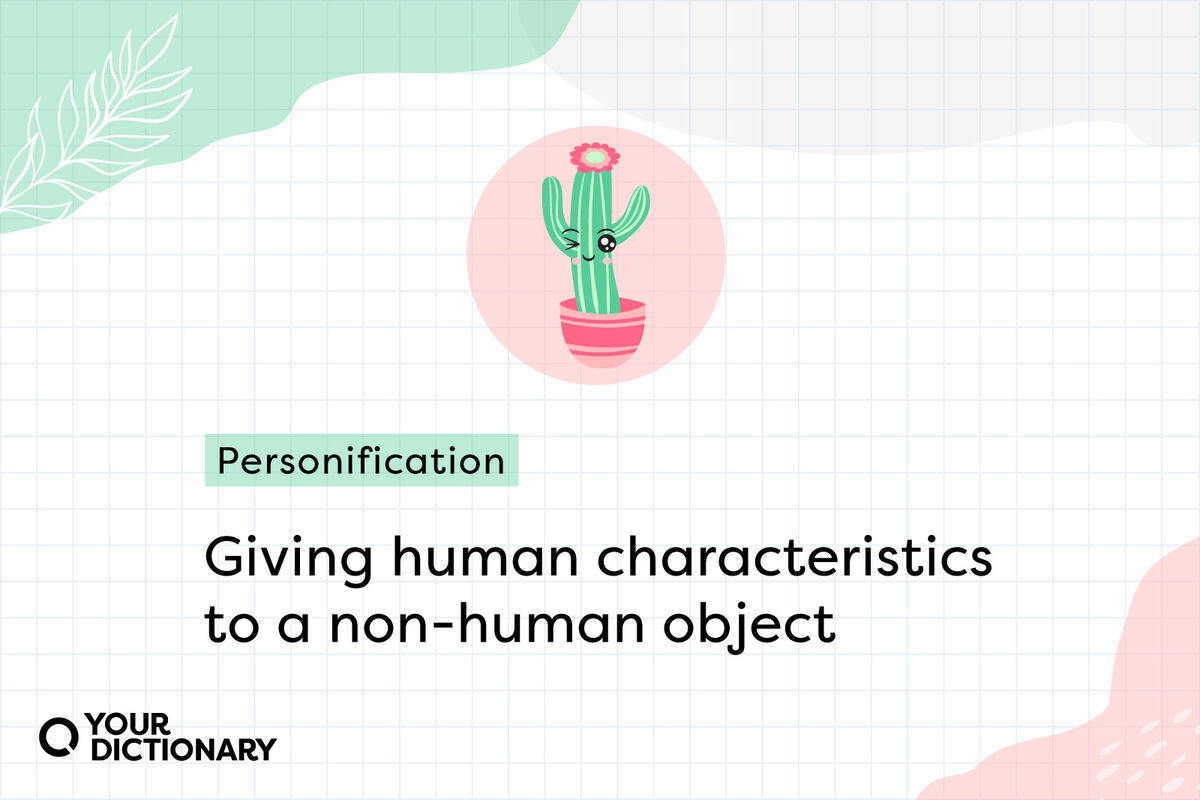
Personification is a type of figurative language that gives human traits to animals, plants, objects, and other non-human things. For example,
- The blanket held me close.
- The computer suffered.
- The dog scolded me.
People can do amazing things, from running and leaping to feeling complex emotions. We are unique in that way. That's why personification is what writers use to bring non-human things to life by giving an animal or object qualities and abilities that only a human can have. This creative literary devices helps us better understand the writer's message and adds interest and fun to poems and stories.
Common Personification Examples
The following are some everyday examples of personification you'll hear people say or see in a book. Each example shows an object exhibiting a human character trait.
- Lightning danced across the sky.
- The wind howled in the night.
- The car complained as the key was roughly turned in its ignition.
- Rita heard the last piece of pie calling her name.
- My alarm clock yells at me to get out of bed every morning.
- The avalanche devoured anything standing in its way.
- The door protested as it opened slowly.
- My house is a friend who protects me.
- The moon played hide and seek with the clouds.
- The approaching car's headlights winked at me.
- The camera loves her since she is so pretty.
- The stairs groaned as we walked on them.
- Our vacuum hums a happy tune while it cleans.
- My flowers were begging for water.
- The ivy wove its fingers around the fence.
- The thunder was grumbling in the distance.
- The cactus saluted those who drove past.
- The wildfire ran through the forest at an amazing speed.
- The moon smiled at the stars in the sky.
- The leaves waved as we passed by.
- Time flies when you're having fun.
Personification in Poetry and Books
There are many examples of personification in literature. This can help to convey different ideas, support imagery, or otherwise create more vivid writing.
“The Fog” by Carl Sandburg
The first example is from Carl Sandburg's "The Fog." In this poem, fog is given the human ability to sit and look.
The fog comes
on little cat feet.
It sits looking
over harbor and city
on silent haunches
and then moves on.
“Hey Diddle Diddle”
The next example is from the popular nursery rhyme "Hey Diddle Diddle." In this rhyme, both animals and objects are able to do things that humans do. This includes laughing and running.
Hey, diddle, diddle,
The cat and the fiddle,
The cow jumped over the moon;
The little dog laughed
To see such sport,
And the dish ran away with the spoon.
“Check” by James Stephens
The following example is from James Stephens "Check." In this example, night is given the human qualities of creeping and being silent.
The night was creeping on the ground!
She crept and did not make a sound.
“The Giving Tree” by Shel Silverstein
The next example is from Shel Silverstein's "The Giving Tree." In this story, the tree has many human emotions and traits. The tree can talk. The tree can give things to the boy and the tree can experience sadness and joy.
And then one day the boy came back and the tree shook with joy.
“The One and Only Ivan” by Katharine Applegate
The following is an example of personification used in The One and Only Ivan by Katharine Applegate. The main character Ivan is a gorilla that is given human qualities. The following lines make it seem like he thinks and expresses himself like a human.
I think for a while. It's hard to put into words. Gorillas are not complainers. We're dreamers, poets, philosophers, nap takers.
“The Day The Crayons Quit” by Drew Daywalt
The last example is from The Day The Crayons Quit by Drew Daywalt. In this book, the crayons feel emotions and act like humans. The crayons express that they had enough of drawing and quit.
I have to color all the Santas at Christmas and all the hearts on Valentine's Day. I need a rest.
Your overworked friend,
Red Crayon
Personification in Advertising
Personification is commonly used in advertising. You will see examples both in print and in television commercials. The following are some examples.
- Milk's favorite cookie - Oreo
- Nothing hugs like Huggies - Huggies diapers
- The snack that smiles back - Goldfish snack crackers
- Kleenex says bless you - Kleenex facial tissues
- The car that cares - Kia
- Unwrap a smile - Little Debbie snack cakes
- It's what happy tastes like - Carvel ice cream
- Gatorade always wins! - Gatorade
There are also a variety of characters used in ads that are perfect examples of personification. The following brands use personification in their advertising.
- M&M's: The M&M candies can walk and talk and have feelings in the ads.
- Cheetos: Chester Cheetah is used to convey messages in the ads for Cheetos. He is seen talking and acting human.
- GEICO: The GEICO gecko delivers the messages in the commercials. He is seen talking and walking around.
- Mucinex: The mucus in the Mucinex commercials come to life to talk and argue.
Bring Characters to Life
Personification is a fun form of figurative language that is used to grab the readers' attention and is a great way to make it easier for kids to relate to the object or animal in a story and understand the writer's message. Try using personification in your next story, poem or classroom assignment. You'll find it can be enjoyable to make a thing act like a human. Personification is just one way of making your writing more interesting and original.
For even more fun with words put your ability to exaggerate to the test with these examples of hyperbole for kids.